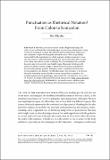Punctuation as rhetorical notation? From colon to semicolon
Abstract
The word punctuation is not used in English until 1593. The earlier term, used from the late Middle Ages, was pointing, which meant a sign system for pausing in reading. This rhetorically based principle of punctuation continued to operate during the sixteenth century but was gradually superseded by the logical system, which mapped out the grammatical structure of a sentence. The punctuation mark that best typifies the earlier system is the colon, since this was used to identify the cola (members) of a periodic discourse and represented a mid-length pause. This essay will discuss different uses of the colon in a range of printed texts from the second half of the sixteenth century (psalms, hexameter verse, translations from Cicero, prose pamphlets, and drama). Neil Rhodes argues that the 1590s is the decade when the semicolon supersedes the colon in a move that encapsulates the broader transition from pointing to punctuation.
Citation
Rhodes , N 2019 , ' Punctuation as rhetorical notation? From colon to semicolon ' , Huntington Library Quarterly , vol. 82 , no. 1 , pp. 87-106 . https://doi.org/10.1353/hlq.2019.0004
Publication
Huntington Library Quarterly
Status
Peer reviewed
ISSN
0018-7895Type
Journal article
Collections
Items in the St Andrews Research Repository are protected by copyright, with all rights reserved, unless otherwise indicated.

